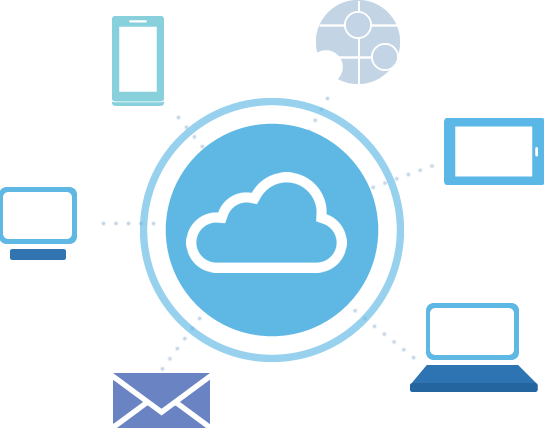- TECHNOLOGIES & SOLUTIONS
- Technologies
- Solutions
CLOUD COMPUTING
According to the definition from the US National Institute of Standards and Technology (NIST)1, cloud computing is 'a model for enabling ubiquitous, convenient, on-demand network access to a shared pool of configurable computing resources (e.g. networks, servers, storage, applications, and services) that can be rapidly
provisioned and released with minimal management effort or service provider interaction'. With the increase in the volume of IoT business, the demand for data storage and computing capacity will continue to increase, thereby increasing the requirements for 'cloud computing' capabilities.
1「IST 的雲計算計劃」,於:http://www. nist.gov/itl/cloud/index.cfm [ 於 2013 年 6 月7日]。
Cloud computing model consists of the following components: five basic characteristics (on-demand self-service, broad network access, resource sharing, rapid elasticity, measurable service), three services model (Software as a Service (SaaS), Platform as a Service (PaaS), Infrastructure as a Service (IaaS)); and four deployment models (private cloud, community cloud, public cloud, hybrid cloud).
Cloud computing technology allows network service providers to handle hundreds of millions of data in a very short time (a few seconds) within. Cloud computing users can use an ordinary PC, a phone, a tablet, etc., to complete the user needs to access and service (Figure 1).
 Figure 1: Cloud Computing User Equipment
Figure 1: Cloud Computing User EquipmentAt present, cloud computing has spawned a variety of applications, such as, cloud-based business application security software, hardware, users, organisations, secure cloud platform (collectively: Cloud Security) and cloud storage. Through a large number of user-clients in a mesh network, cloud security monitors the behaviour of software on the network and gets the latest news on Trojan horses and malware, and sent to the server for automatic analysis and processing, then distributes viruses and Trojans solutions to each client. Cloud storage is a new concept extended from cloud computing, and refers to a system that provides access from the outside and to make business visits, using such functions as cluster applications, network technologies or a distributed document system in a co-operatively manner by software on different types of storage devices. Application of software together work to provide a system of external data storage and business access functions. In simpler terms, cloud storage is a new solution that puts the stored resources to be retrieved on the cloud at anytime, anyplace. Any device can be connected through a network connection to the cloud, and easily-accessible information. Other includes cloud-based applications computing technology: cloud call centre, cloud conference, cloud social networking and so on.
In China, applications using cloud computing technology are becoming more popular. An example is TOPSEC, a provider of information security products and services solutions, which has introduced the Yangzhou cloud security system solution based on the actual security needs of cloud computing centres coupled with its own experience in cloud security and its cloud security products. The Yangzhou cloud safety system has established a high-performing highly reliable, highly secure, easily managed, easy-to-expand cloud security platform, and through the cloud security management platform provides dynamic and flexible cloud computing security services for e-government cloud2.
2沈余峰,「揚州政務雲成功案例」,雲安 全 -- 華麗大幕背後的危機,2013 年 4 月。
With the further development of cloud computing, cloud computing will be able to be used in more areas:
- 1Medicine and healthcareThe information-centric application model that puts 'cloud information platform' as its core will enhance the ability of pharmaceutical companies to share information internally, as well as the overall service of public platforms to share medical information.
- 2ManufacturingCloud computing will help in the establishment of corporate cloud supply chain information platform, thereby accelerating the process of information integration of 'Development - Procurement - Production - Inventory - Sales'.
- 3Financial and energy sectorsCloud computing model will become the 'key weapon' in information integration in financial, energy and other large enterprises.
- 4E-governmentCloud computing will assist Chinese government of all levels to establish a 'public service platform'.
- 5Education and researchIn the future, cloud computing will provide a practical platform for research and development for universities and research institutes.
- 6TelecommunicationsChinese telecommunications enterprises will be able to gain sizable revenues from the provision of all kinds of paid cloud services and products.
However, the development of cloud computing also faces many challenges. Firstly, it is difficult to prevent illegal usage of data stored by the cloud service providers, as well as to safeguard such information; Secondly, the question of how to change users' habits so that they are accustomed to using network-based hardware and software applications needs to be tackled; Thirdly, there is the question of network transfers and the lack of uniform technical standards. All these will pose serious challenges to the widespread adoption of cloud computing in the future3.
3「IST 的雲計算計劃」,於:http://www. nist.gov/itl/cloud/index.cfm [ 於 2013 年 6 月 7 日 ]。


